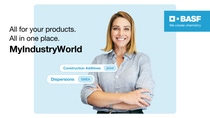MyIndustryWorld
Self-leveling compounds
Self-leveling underlayments are used to create a smooth and level surface on top of existing concrete or subfloors. They most often prepare the surface for installation of various floor coverings, such as tile, carpet, vinyl, or hardwood in both residential and commercial settings, including basements, kitchens, bathrooms, and retail spaces.

For flat and even floors
Underlayments that level themselves offer several benefits. They can help correct uneven or sloping floors, fill in low spots, and smooth out surface imperfections. Underlayments also provide a stable and durable foundation for the installation of floor coverings, helping prevent cracks and unevenness.
Self-leveling underlayments are typically made of a blend of cement, aggregates, and BASF additives. When mixed with water, they form a fluid-like consistency that can easily flow and spread across a floor surface. Once poured, a self-leveling underlayment settles and levels itself to create a flat and even base.
Highlight products
Discover

The SLU Dream Team: Our latest SLU formulation combining Melflux® SELECT 6030 F and HyCon® R 3660 F

Access your PCF data online

How to read your PCF statement

Discover „MyIndustryWorld“ - the new service portal of BASF
Choose your application:
Contact us
Not found what you were looking for? Reach out to us for assistance.
Subscribe to our News-Service
Don’t miss the latest news on web seminars, sustainability, regulatory and product innovations.
Contacts worldwide


.jpg)










